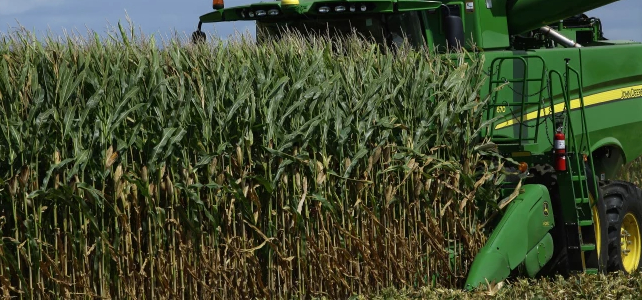June 8, 2025 | 06:34 GMT +7
June 8, 2025 | 06:34 GMT +7
Hotline: 0913.378.918
June 8, 2025 | 06:34 GMT +7
Hotline: 0913.378.918

A central Illinois corn farmer begins to harvest this years crops of corn in Pleasant Plains, Ill. Wet, cool conditions across much of Illinois have put farmers behind schedule in bringing their corn in from the fields, according to the U.S. Department of Agriculture. Photo: AP/Seth Perlman
Russia previously accounted for 15% of U.S. fertilizer imports.
"We have heard that some farmers have balked at buying at the high prices and have not filled their needs, hoping prices will go down," Nebraska farmer John Dittrich, who grows both corn and soybeans, told MarketWatch.
Prices for some types of fertilizer cost a record $1,520 per ton, an increase of 127% this year. Corn is up 4%, at nearly $7.67 per bushel. As a result, 4 million fewer acres of corn will be planted, while soybean crops will increase by the same amount, MarketWatch reported.
Soybeans put nitrogen back into the ground rather than extract it, so they only need a small amount of fertilizer when compared to corn. Previously, the average farmer used 255 pounds of fertilizer for corn, compared to 65 pounds for soybeans, Bloomberg reported.
But fertilizer is just one part of the equation when it comes to rising food prices. Farmers have also endured rising costs for livestock feed, fuel, machine parts, and herbicide.
To make matters worse the Midwest is experiencing drought-like conditions that yield poor crops.
“It feels like going down the hill in a truck and picking up speed but not being sure if you can make that corner at the bottom,” Iowa farmer John Gilbert said of the numerous calamities that growers are enduring.
Chicago soybeans fall further on record US acreage forecast
Chicago soybeans fell for a second day on Friday to hit a one-month low after a U.S. Department of Agriculture (USDA) forecast of record U.S. soy acreage pressured the market. Corn was little changed after the previous day’s rise as the market weighed the USDA’s lower-than-expected projection of U.S. corn planting against weakness in crude oil.
Wheat rose, helped by a lower-than-expected USDA estimate of spring wheat seedings and uncertainty over the course of the conflict between Russia and Ukraine, both major grain exporters.
The most active soybean contract on the Chicago Board of Trade (CBOT) was down 0.6% at $16.09 per bushel by 1112 GMT. It earlier hit its lowest since February 25 but held above the $16 chart threshold. The USDA projected that U.S. farmers would plant the most soybean acres on record this spring while reducing corn acreage to a level below a range of analyst estimates.
"The pronounced shift in acreage from corn to soybeans is probably due to the sharp rise in fertilizer prices," Commerzbank said.
Soybeans require less fertilizer than corn, making the oilseed more attractive to farmers as high costs and tight supply of fertilizer have been exacerbated by the conflict in Ukraine. Soybeans also faced pressure from a slide in crude oil on Thursday after the United States announced a record release of its strategic oil reserves to curb high fuel prices. The slide in crude oil also capped corn prices. Like soybean oil, corn is widely used in biofuels. Crude was little changed on Friday ahead of a meeting of consuming nations. CBOT corn edged down 0.3% to $7.46¾ a bushel after adding more than 1% on Thursday.
CBOT wheat rose 2.2% to $10.27¾ a bushel, helped by strength in MGEX spring wheat futures after the USDA’s acreage report. A separate USDA estimate of U.S. quarterly wheat stocks at a 14-year low also underpinned the cereal market. Following losses earlier this week, market participants were also adjusting positions in wheat before the weekend, with developments in the Ukraine war unclear, traders said.
Prices at 1112 GMT Last Change Pct End Ytd Pct Move 2021 Move CBOT wheat 1027.75 21.75 2.16 770.75 33.34 CBOT corn 746.75 -2.00 -0.27 593.25 25.87 CBOT soy 1609.00 -9.25 -0.57 1339.25 20.14 Paris wheat 370.00 0.50 0.14 276.75 33.69 Paris maize 323.00 0.25 0.08 226.00 42.92 Paris rape 931.75 -9.25 -0.98 754.00 23.57 WTI crude oil 100.16 -0.12 -0.12 75.21 33.17 Euro/dlr 1.11 0.00 -0.07 1.1368 -2.74 Most active contracts - Wheat, corn and soy US cents/bushel, Paris futures in euros per tonne.
(Washingtonexaminer; Reuters)

(VAN) With the war ongoing, many Ukrainian farmers and rural farming families face limited access to their land due to mines and lack the financial resources to purchase needed agricultural inputs.

(VAN) Vikas Rambal has quietly built a $5 billion business empire in manufacturing, property and solar, and catapulted onto the Rich List.

(VAN) Available cropland now at less than five percent, according to latest geospatial assessment from FAO and UNOSAT.

(VAN) Alt Carbon has raised $12 million in a seed round as it plans to scale its carbon dioxide removal work in the South Asian nation.

(VAN) Attempts to bring down the price of the Japanese staple have had little effect amid a cost-of-living crisis.

(VAN) Fourth most important food crop in peril as Latin America and Caribbean suffer from slow-onset climate disaster.

(VAN) Shifting market dynamics and the noise around new legislation has propelled Trouw Nutrition’s research around early life nutrition in poultry. Today, it continues to be a key area of research.